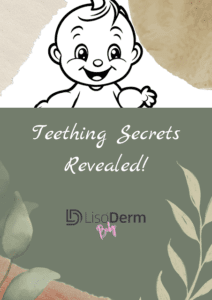As parents, caregivers, or anyone involved in the upbringing of a child, navigating the various stages of growth and development can be both rewarding and challenging. One such stage, teething, is a significant milestone in a baby’s life, often marked by discomfort and a multitude of symptoms that can leave parents feeling overwhelmed and unsure of the best course of action.
This article aims to provide a comprehensive, informative, and accessible guide to understanding teething in babies, covering everything from recognizing the signs and symptoms to exploring various soothing strategies, remedies, and professional guidance. With a touch of creativity and a wealth of knowledge, our goal is to empower you with the tools and confidence to support your little one through the teething journey, ensuring their comfort and well-being every step of the way.
Table of Contents
- Introduction: Teething in Babies
- Understanding Baby Teething: What’s Happening?
- The Signs and Symptoms of Teething
- Comforting Your Little One: Soothing Strategies
- Natural Remedies for Teething Discomfort
- Over-the-Counter Solutions: When to Use and What to Avoid
- Teething Myths and Misconceptions
- Caring for Your Baby’s Teeth: Dental Hygiene Tips
- Teething Troubles: When to Consult a Pediatrician
- Conclusion: Supporting Your Baby Through the Teething Journey

Important Points to Remember
| Section | Key Takeaways |
|---|---|
| Understanding Baby Teething | Teething is a natural developmental process that involves the eruption of primary teeth in infants, typically occurring between 6 and 24 months of age. |
| Signs and Symptoms of Teething | Common indicators of teething include drooling, irritability, gum swelling, and sleep disturbances. It’s crucial to differentiate teething symptoms from illness. |
| Comforting Your Little One | Gentle gum massages, cold therapy, and distraction techniques can help alleviate teething discomfort and provide relief for your baby. |
| Natural Remedies for Teething Discomfort | Herbal teas, aromatherapy, and homeopathic alternatives are natural options to consider for managing teething symptoms, but always consult a pediatrician before trying new remedies. |
| Over-the-Counter Solutions | Acetaminophen, ibuprofen, and teething gels are available options for pain relief. Be cautious and consult a healthcare professional before administering any over-the-counter products. |
| Teething Myths and Misconceptions | Amber teething necklaces lack scientific evidence, and teething doesn’t cause high fever. Stay informed and rely on evidence-based information for your baby’s care. |
| Caring for Your Baby’s Teeth | Introduce toothbrushing with a soft, infant-sized toothbrush as soon as the first tooth appears. Choose appropriate toothpaste and schedule regular dental check-ups for optimal oral health. |
| Teething Troubles and Pediatricians | Consult a pediatrician if your baby shows signs of serious complications or persistent discomfort. Collaboration with your healthcare provider is essential for optimal care during the teething process. |
Introduction: Teething in Babies
Teething, a natural and momentous milestone in an infant’s development, often evokes a mix of elation and trepidation in new parents. This transformative phase sees the arrival of your baby’s first set of pearly whites, a crucial step towards their journey to self-sustenance. In this comprehensive article, we will navigate the multifaceted aspects of teething, dispelling myths, and providing essential guidance for soothing your little one through this challenging phase.
From understanding the teething process to identifying the signs and symptoms, we will explore various remedies and strategies to alleviate your baby’s discomfort. Additionally, we will discuss dental hygiene tips and when to consult a pediatrician. Let this article serve as your ultimate resource to support your baby through their teething journey, as you foster their growth and development with confidence and care.
See Also:Do Babies Need Teethers? Benefits and Risks
Understanding Baby Teething: What’s Happening?
An Overview of the Teething Process
Teething, a physiological process that all infants undergo, marks the emergence of their primary teeth through the gums. This usually occurs between the ages of 6 and 24 months. The teething process is initiated by the activity of odontogenesis, the formation of teeth within the jawbones. As the teeth continue to develop, they slowly push through the gum tissue, culminating in the appearance of the deciduous teeth, colloquially known as “baby teeth”.
Each tooth’s eruption follows a predictable pattern, starting with the incisors (front teeth), followed by the canines, and finally the molars. The teething process is completed once all 20 primary teeth have surfaced, typically by the age of three. Though teething can be an uncomfortable experience for the infant, understanding the process and providing appropriate support can mitigate the challenges and discomfort.
The Timeline of Tooth Eruption in Infants
The timeline of tooth eruption may vary among infants, but a general pattern can be observed. The lower central incisors typically emerge first, around 6 to 10 months of age, followed by the upper central incisors between 8 and 12 months. The lateral incisors, both upper and lower, surface between 9 and 16 months. Canines tend to appear between 16 and 22 months, while the first molars emerge between 13 and 19 months. Lastly, the second molars typically make their appearance between 23 and 33 months of age.
While deviations from this timeline are not uncommon, it is essential to monitor your child’s tooth eruption progress and consult a pediatric dentist if any concerns arise. This ensures that any potential dental issues are addressed promptly, safeguarding your child’s oral health.
The Signs and Symptoms of Teething
Common Physical Indicators
As your baby begins to teethe, several physical signs may manifest, signaling that their primary teeth are on the verge of eruption. These indicators can include swollen, red, or tender gums, and in some cases, a visible tooth bud beneath the gum’s surface. Additionally, many infants may experience excessive drooling, which can lead to skin irritation and rashes around the mouth and chin.
It is essential to keep a watchful eye on these physical signs, as they can help you prepare for the necessary soothing measures to help your baby through this uncomfortable phase. While some symptoms may be mild and tolerable, others can cause significant distress, requiring prompt attention and intervention.
Behavioral Changes During Teething
Beyond the physical indicators, teething often brings about behavioral changes in infants. Common signs include increased irritability, fussiness, and disrupted sleep patterns, as the discomfort may make it difficult for them to rest. Some babies may also exhibit a loss of appetite or refusal to nurse or bottle-feed, as the pressure on their gums may exacerbate the pain.
Additionally, teething infants may develop a proclivity for gnawing or biting on objects, as applying pressure to their gums can provide temporary relief. Being attentive to these behavioral changes allows parents to address their baby’s needs and offer comfort throughout the teething process.
How to Differentiate Between Teething and Illness
Discerning between teething-related discomfort and illness can be challenging, as certain symptoms may overlap. While mild fever and diarrhea are occasionally attributed to teething, they may also indicate the presence of an infection or other health concerns. To differentiate between the two, it is crucial to closely monitor your baby’s symptoms and consult a pediatrician if the fever persists, if diarrhea worsens, or if additional symptoms emerge.
Erring on the side of caution and seeking medical advice can ensure that potential health issues are promptly addressed, safeguarding your baby’s overall well-being while they navigate the teething process.
See Also : Endless Crying? Learn How to Soothe Your Baby | When Your Baby Won’t Stop Crying
Comforting Your Little One: Soothing Strategies
Massage and Pressure: A Gentle Touch
Offering a gentle gum massage can be an effective way to alleviate your baby’s teething discomfort. Using a clean finger or knuckle, apply light pressure and circular motions to the affected area. This simple technique can provide immediate relief by counteracting the pressure exerted by the emerging tooth. Additionally, this tender touch can foster a sense of security and bonding between parent and child during this trying phase.
Another option is to provide your baby with a safe, textured teething toy to chew on, as the counterpressure can help alleviate the pain. It is essential to ensure that the teething toy is clean and age-appropriate to avoid potential choking hazards.
Cold Therapy: Chilled Teething Toys and Foods
Cold therapy can be an effective method for reducing teething-related inflammation and pain. Chilled teething rings or toys, specifically designed for this purpose, can offer respite to your baby’s sore gums. Be sure to avoid freezing these items, as extreme cold can harm your baby’s delicate oral tissues. A refrigerated temperature is sufficient to provide relief.
Alternatively, cold foods such as yogurt, applesauce, or pureed fruits can be offered to babies who have already been introduced to solid foods. Not only do these chilled treats soothe pain, but they also provide a nutritious snack for your little one. Always supervise your baby while they consume solid foods to prevent choking hazards.
Distraction Techniques: Playtime and Entertainment
Though it may seem simple, providing ample playtime and entertainment can serve as an effective distraction from teething discomfort. Engaging your baby in age-appropriate activities, such as playing with toys, listening to music, or enjoying a gentle cuddle, can help shift their focus away from the pain and provide a sense of comfort.
Additionally, incorporating an element of touch, such as gentle rocking or stroking, can foster feelings of security and reassurance during this trying phase. Remember that your presence and attention are invaluable sources of solace for your baby during the teething process.
Natural Remedies for Teething Discomfort
Herbal Teas and Gums
Herbal remedies can offer a natural approach to alleviating teething discomfort. Some parents may choose to explore options such as chamomile or fennel tea, which are known for their soothing properties. To administer, soak a clean cloth or gauze in the cooled tea and allow your baby to gnaw on it for relief.
Other natural remedies include the use of licorice root or marshmallow root, which have been traditionally employed to soothe inflammation and irritation. As with any alternative remedy, it is crucial to consult a healthcare professional before using herbal products to ensure their safety and appropriateness for your baby.
Aromatherapy: Essential Oils for Relief
Aromatherapy, utilizing the therapeutic properties of essential oils, can offer a calming and soothing environment for your teething baby. Lavender, chamomile, and frankincense are known for their relaxing and anti-inflammatory properties, which may help alleviate your baby’s discomfort.
It is essential to use essential oils sparingly and appropriately, always diluting them in a carrier oil before applying them to your baby’s skin. Alternatively, a diffuser can be used to disperse the oil’s aroma in your baby’s room. Always consult a healthcare professional before incorporating essential oils into your baby’s care routine.
Homeopathic Options: Safe and Gentle Alternatives
Homeopathy offers another avenue for parents seeking natural remedies to soothe teething discomfort. Homeopathic teething tablets or gels, which contain diluted amounts of various natural substances, are designed to provide gentle relief from teething symptoms. Popular ingredients include Chamomilla, Calcarea Phosphorica, and Belladonna.
While many parents report positive results with homeopathic remedies, it is crucial to consult a healthcare professional before using these products. This ensures that the chosen remedy is appropriate for your baby and avoids any potential adverse effects or interactions.
Over-the-Counter Solutions: When to Use and What to Avoid
Pain Relievers: Acetaminophen and Ibuprofen
In cases where natural remedies and soothing strategies are insufficient, over-the-counter (OTC) pain relievers may be considered. Acetaminophen (Tylenol) and ibuprofen (Advil, Motrin) are both effective in alleviating teething discomfort when administered according to the recommended dosage for your baby’s age and weight.
It is important to consult your pediatrician before administering any medication to your baby, as they can provide guidance on the appropriate dosage and frequency. Be sure to follow the pediatrician’s recommendations and the instructions on the medication’s label to ensure your baby’s safety.
Teething Gels: The Pros and Cons
Teething gels, another OTC option, can provide temporary relief by numbing the affected area. These gels typically contain a local anesthetic, such as benzocaine, which helps alleviate gum discomfort. However, the FDA advises against the use of benzocaine-containing products for children under two years of age, as they may cause a rare but serious condition called methemoglobinemia, which affects oxygen levels in the blood.
Furthermore, the numbing effect of teething gels can be short-lived, requiring frequent reapplication. If you are considering the use of a teething gel, consult your pediatrician to discuss the risks and benefits, and to explore alternative options if necessary.
Choosing the Right OTC Product for Your Baby
Selecting the appropriate OTC product for your baby requires careful consideration and consultation with a healthcare professional. It is crucial to weigh the potential benefits against the risks associated with any medication or remedy, ensuring that your baby’s safety and well-being remain the top priority.
When in doubt, always consult your pediatrician or pharmacist for guidance, and be sure to follow their recommendations and the instructions on the product’s label. By taking a cautious and informed approach, you can provide your baby with the relief they need while navigating the teething process.
See Also : Creating the Perfect Sleep Environment for Your Newborn
Teething Myths and Misconceptions
Amber Teething Necklaces: Fact or Fiction?
Amber teething necklaces, purported to provide relief from teething discomfort, have become a popular accessory among parents. The theory behind their efficacy lies in the belief that when worn against the skin, body heat releases succinic acid from the amber beads, which is then absorbed by the baby, providing analgesic and anti-inflammatory effects.
However, there is little scientific evidence to support these claims, and the use of amber teething necklaces poses significant risks, such as strangulation and choking hazards. As such, it is advisable to exercise caution and consider alternative, evidence-based methods for alleviating teething discomfort.
Do Teething Babies Really Have a Fever?
A common misconception is that teething can cause high fevers in infants. While a slight increase in temperature may be observed during the teething process, high fevers are generally not a symptom of teething and may indicate an underlying illness or infection. If your baby develops a high fever, it is essential to consult a pediatrician promptly to address any potential health concerns.
Common Misunderstandings Surrounding the Teething Process
Teething is often shrouded in myths and misconceptions, which can make it difficult for parents to discern fact from fiction. Common misunderstandings include the belief that teething causes diarrhea, that all babies experience significant pain, and that teething can last for months without any teeth appearing. It is important to remember that each baby is unique and may experience teething differently. As a parent, educating yourself on the facts and consulting healthcare professionals can help guide you through this developmental milestone with confidence.
Caring for YourBaby’s Teeth: Dental Hygiene Tips
Introducing Toothbrushing: A Step-by-Step Guide
As your baby’s teeth begin to emerge, establishing a dental hygiene routine is essential for promoting lifelong oral health. Begin by using a soft, infant-sized toothbrush with a small smear of fluoride toothpaste (about the size of a grain of rice) to gently clean your baby’s teeth twice daily. As they grow and more teeth appear, gradually increase the amount of toothpaste to a pea-sized dollop.
Encourage your child to spit out the toothpaste after brushing, but avoid rinsing their mouth with water, as this can dilute the protective effects of fluoride. As your child develops the necessary motor skills, you can gradually teach them to brush their teeth independently, while still providing supervision and assistance as needed.
Selecting the Right Toothpaste for Your Infant
Choosing the appropriate toothpaste for your baby is vital for ensuring their oral health. Look for a product that contains fluoride, which helps strengthen tooth enamel and prevent cavities. It is also essential to select a toothpaste specifically designed for infants and toddlers, as these formulations typically contain lower levels of fluoride, making them safe for young children who may inadvertently swallow some toothpaste while brushing.
As a general rule, avoid toothpaste with added sugars, artificial colors, or strong flavors that may be off-putting for your baby. A mild, pleasant flavor can make the toothbrushing experience more enjoyable and encourage healthy habits from an early age.
When to Schedule Your Baby’s First Dental Visit
Establishing a relationship with a pediatric dentist early in your child’s life is crucial for their long-term oral health. The American Academy of Pediatric Dentistry recommends scheduling your baby’s first dental appointment when their first tooth appears or no later than their first birthday. This initial visit allows the dentist to assess your child’s oral health, provide guidance on dental hygiene practices, and address any concerns or questions you may have.
Regular dental check-ups, typically every six months, will ensure that your child’s teeth and gums remain healthy and provide an opportunity to address any potential issues before they become more significant problems.
Teething Troubles: When to Consult a Pediatrician
Red Flags: Signs of Serious Complications
While teething is a natural and expected developmental milestone, there are instances where complications may arise, warranting consultation with a pediatrician. Red flags to watch for include high fever, severe diarrhea or vomiting, persistent pain, or signs of infection, such as pus or excessive swelling around the gums.
Monitoring your baby’s symptoms closely and seeking medical advice when necessary can ensure that any serious complications are promptly addressed, safeguarding your baby’s overall well-being.
Managing Persistent Symptoms and Discomfort
Some babies may experience prolonged or more severe teething symptoms, which can be distressing for both the child and their parents. If your baby continues to struggle with teething discomfort despite your best efforts, consulting a pediatrician can provide guidance on additional strategies or interventions that may be necessary to alleviate their pain.
By partnering with your pediatrician, you can ensure that your baby receives the care and support they need throughout the teething journey.
Partnering with Your Pediatrician for Optimal Care
Collaborating with your pediatrician is essential for navigating the teething process with confidence and ensuring your baby’s well-being. Regular check-ups and open communication with your healthcare provider can help address any concerns, identify potential complications, and provide guidance on the best strategies for managing your baby’s teething symptoms.
Remember that your pediatrician is an invaluable resource for you and your baby during this significant developmental milestone, and their expertise can help you make informed decisions about your baby’s care.
Conclusion: Supporting Your Baby Through the Teething Journey
Teething is an inevitable and often challenging phase in your baby’s development, marked by discomfort, sleep disturbances, and a myriad of other symptoms. As a parent, understanding the teething process, recognizing the signs and symptoms, and employing effective soothing strategies can help ease your baby’s discomfort and provide much-needed relief.
Exploring natural remedies, over-the-counter solutions, and consulting healthcare professionals can further support your efforts to guide your baby through this journey. By staying informed, proactive, and compassionate, you can help your little one navigate the teething process with as much comfort and ease as possible.
Ultimately, the teething journey is just one of many developmental milestones your baby will experience, and your unwavering support and care will help them grow into healthy, happy children.
FAQs
1. What are some common indicators that a baby is teething?
Common signs of teething include drooling, fussiness, irritability, gum swelling or redness, biting or gnawing on objects, difficulty sleeping, and a decrease in appetite. Each baby may experience teething differently, so it’s essential to observe and understand your baby’s unique symptoms.
2. How can I help alleviate my baby’s teething discomfort?
There are various soothing strategies you can try, such as gently massaging your baby’s gums with a clean finger, offering chilled teething toys or foods, and engaging them in playtime to provide distraction. Additionally, you can explore natural remedies like herbal teas, aromatherapy, and homeopathic alternatives or seek over-the-counter solutions like pain relievers and teething gels.
3. When should I introduce toothbrushing to my baby?
Begin introducing toothbrushing as soon as your baby’s first tooth emerges. Use a soft, infant-sized toothbrush with a small smear of fluoride toothpaste and gently clean your baby’s teeth twice daily. Gradually increase the amount of toothpaste as your baby grows and more teeth appear.
4. What is the recommended timeline for a baby’s first dental visit?
The American Academy of Pediatric Dentistry advises scheduling your baby’s first dental appointment when their first tooth appears or no later than their first birthday. Regular dental check-ups, typically every six months, will help ensure that your child’s teeth and gums remain healthy.
5. What are some red flags that may indicate complications during teething?
Signs of serious complications during teething include high fever, severe diarrhea or vomiting, persistent pain, or signs of infection such as pus or excessive swelling around the gums. If your baby exhibits any of these red flags, consult a pediatrician for further evaluation and guidance.
6. Are there any myths or misconceptions surrounding the teething process?
Yes, some common misconceptions include the belief that teething causes high fever, amber teething necklaces provide pain relief, and that all babies experience teething symptoms similarly. It’s essential to stay informed and rely on evidence-based information to ensure your baby’s well-being.
7. How can I collaborate with my pediatrician to ensure optimal care during teething?
Regular check-ups and open communication with your pediatrician can help address any concerns, identify potential complications, and provide guidance on managing your baby’s teething symptoms. Partnering with your pediatrician ensures that your baby receives the care and support they need throughout the teething journey.








